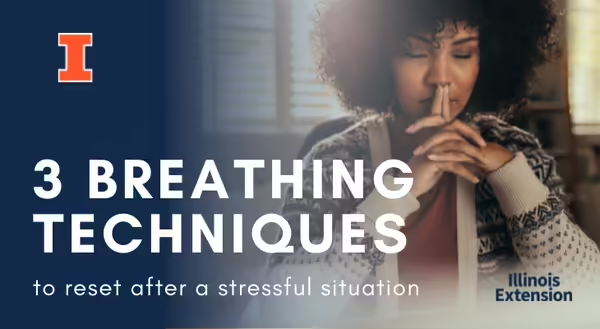
In my family, when interactions start to escalate or an argument is spiraling out of control, you can often hear one of us say the words, “Can we have a restart?” That’s a sign that someone has recognized this interaction isn’t headed in a good direction and we need to take a step back. Being able to acknowledge you need to take a moment is an important step in managing your emotions. Equally important, yet sometimes more challenging is the actual resetting of your emotions. Mindfulness techniques are a great way to help your body and mind reset to a more peaceful state. These three techniques are good ones to try when trying to reset after a stressful situation.
- 4-7-8 Breathing. This technique helps release the fight or flight response that your body goes into during times of stress. Begin by breathing in through your nose for the count of 4. Then hold your breath for the count of 7. Try to observe the pressure building without tensing your muscles. Exhale for the count of 8. Try to let out all the air from your lungs during that time. Repeat for 5 rounds.
- Progressive Muscle Relaxation. This technique can help release the stress that can build up in your muscles in a stressful situation. Sit in a comfortable chair or lie down and, slowly and intentionally, contract (tense) the muscle groups in your body for 4-10 seconds. Then release the tension and relax that muscle group. Be sure to breathe deeply as you work through all your major muscle groups. You can use the order listed if it's helpful. (feet, ankles & calves, knees, thighs, hips & pelvic floor, abdomen, hands, arms, back, chest & shoulders, face)
- Notice Your Surroundings. This technique can help take your mind of the stressful moment at hand and reset your thinking. Take a few moments to focus only on your surroundings. Breathe deeply and make a mental list of the items below. Try not to attach any meaning or value to your observations.
- 5 things you can see.
- 4 things you can touch
- 3 things you can hear
- 2 things you can smell
- 1 thing you can taste
Everyone responds differently to these types of techniques, and you will most likely find that one strategy works better for you than others or certain ones may be more effective in different situations. Keeping a list of your favorite mindfulness techniques can be helpful for future reference.
MEET THE AUTHOR
Judy Schmidt provides leadership to 4-H metro programming in Peoria County. Schmidt joined Extension in 2001, working as a Youth Development Educator at the East Peoria Center and joined the Fulton-Mason-Peoria-Tazewell unit in 2011. Her work focuses on 4-H youth development programming in the local metropolitan area, specifically leading positive youth development initiatives for after-school programs, community groups, 4-H clubs and other youth-serving organizations. Her areas of expertise include positive youth development principles, youth leadership, and work with teens as teachers.
Schmidt attended the University of Illinois at Urbana-Champaign for her bachelor's degree in psychology and also for her master's degrees in Social Work and Marriage and Family Therapy. She is a certified facilitator of the Matrixx System/Real Colors program by the National Curriculum and Training Institute.
ABOUT THE BLOG
Connection Corner: is a blog that provides timely information, activities, and resources to help you stay connected to loved ones, the world around you, and yourself.